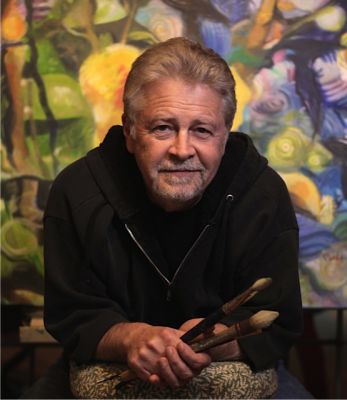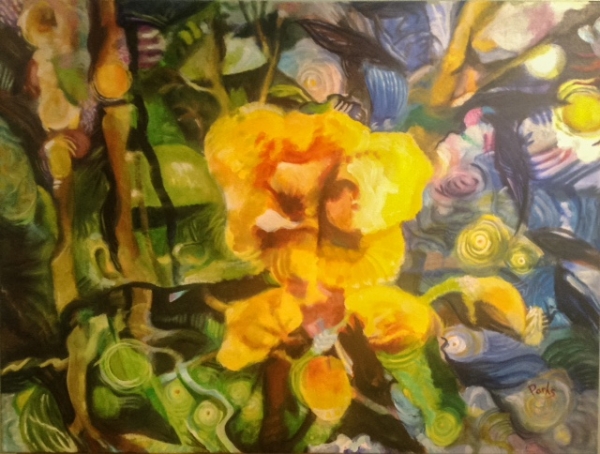 Jim Parks is an Evanston artist who is the latest to be featured in our ongoing exhibition series Local Art @ EPL. In 2015 – after a long career in theater, radio, and television as the host of HGTV’s “New Spaces” – he converted his dining room into a studio and devoted himself “to producing the art that had been waiting inside all those years.” You can catch his exhibit The Bloomz Collection through the end of August on the 2nd floor of EPL’s Main Library, and you can find more of his nature-inspired acrylic paintings by visiting his website. We recently spoke with Parks via email about his vibrant “botanical abstracts,” getting inspired by Louis Comfort Tiffany, and his dreams of the artistic big leagues.
Jim Parks is an Evanston artist who is the latest to be featured in our ongoing exhibition series Local Art @ EPL. In 2015 – after a long career in theater, radio, and television as the host of HGTV’s “New Spaces” – he converted his dining room into a studio and devoted himself “to producing the art that had been waiting inside all those years.” You can catch his exhibit The Bloomz Collection through the end of August on the 2nd floor of EPL’s Main Library, and you can find more of his nature-inspired acrylic paintings by visiting his website. We recently spoke with Parks via email about his vibrant “botanical abstracts,” getting inspired by Louis Comfort Tiffany, and his dreams of the artistic big leagues.
Evanston Public Library: Can you tell us a little about your background as an artist? How did you get started in art? Was there something specific in your life that sparked a need to create?
Jim Parks: I was always the kid with the pencil or paintbrush. In fact I was six or seven when I first heard the word “artist” applied to me. But since my working life was spent either in show biz or broadcasting, I was a doodler until October 2016 when, at the age of 65, I changed our dining room into a studio and got serious about painting. Since then I’ve been fairly prolific, working mostly on 40” x 30” canvases. Many of them are on display on the second floor of the library right now. There was no single insight that sparked a need to create. Rather, there was a constant observation of nature that was begging me — rather insistently — to represent it all in paint.
EPL: How do you describe your paintings? Do you see yourself as fitting in with any particular artistic movements or styles?
JP: I’ve been describing my paintings as “botanical abstracts,” meaning they are based on flowers but with my own twist. When you get up close, it’s easy to lose the connection to the image of any particular flower and find yourself lost in an abstract, undefined world. In fact, when you examine the foliage that surrounds the star of the show (the flower) it will be like staring at the foliage in a garden and becoming aware of the complexity of activity in the shadows. I think that’s pretty cool, and I spend a lot of time trying to get the subtleties of the shadows right. The Impressionists were marvelous in their observation of nature and worked to express it in paint. I stand in awe of the symphonic use of color in a Monet water lily painting or the diversity of texture in a Van Gogh so I guess I identify most closely to Impressionism.

EPL: Can you describe the techniques you used to create a specific painting?
JP: I work exclusively in acrylics. Acrylics dry amazingly fast – except for the newest generation, called “Open.” The downside is that I don’t have the time to work in other colors while they’re wet, as I would in oils. The upside is that I can apply many, many thin layers rather quickly, and this builds-up effects. The lower layers shine through the upper layers so there is a depth that can be achieved. I call this layering “maturing” a color because it isn’t a flat tone out of the tube. The layers give the original color more depth, more gravitas.
EPL: What are your future goals and plans as an artist?
JP: I want to develop a body of work that becomes accepted into the higher levels of the gallery world. I just started a series that takes a step beyond the pretty pictures I’ve been making for the last year and a half. The series will still be grounded in organic forms of nature but will add other elements. One of those elements is based on the work of stained glass artists like Louis Comfort Tiffany. The nature of stained glass is to isolate a shape — a leaf, say — in a framework of black leading, making the color of the leaf more dramatic as the light shines through. The leading that wraps around all the leaves, all the shapes, forms the overall structure of the piece: very solid, very defined. I like that structure, that drama, and I can approximate that in paint. We’ll see if the gallery gate-keepers salute.
EPL: How do you find Evanston and the Chicagoland area as a place to work and exhibit as an artist? What inspires you as an artist about the community where you live?
JP: I love Evanston; I’ve lived here since I was nine. At the moment, I’ve got paintings hanging in four different locations in downtown Evanston, so I couldn’t ask for more acceptance. Evanston as “Tree City,” with the lakefront and all the majestic trees, has always been inspirational. Every walk by the lakefront yields a new idea. Chicago has the River North gallery district with its gravitational pull in the art world, and I’ve got my sights set on that world. And then there’s always the big leagues: New York. Stay tuned.
